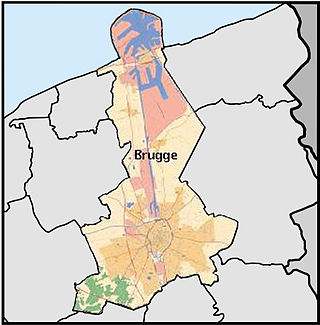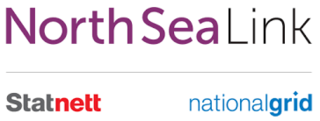
The HVDC Cross-Channel is the 73-kilometre-long (45 mi) high-voltage direct current (HVDC) interconnector that has operated since 1986 under the English Channel between the continental European grid at Bonningues-lès-Calais and the British electricity grid at Sellindge. The cable is also known as IFA, and should not be confused with the new IFA-2, another interconnect with France that is three times as long but only half as powerful.

Fluxys is a Belgium-based company, mainly acting as a natural gas transmission system operator. In 2004, it employed around 850 people and its infrastructure comprised about 3,700 km (2,300 mi) of pipelines and a terminal in Zeebrugge, Belgium. The company is listed on Euronext Brussels market.

The Moyle Interconnector is a 500 megawatt (MW) HVDC link between Scotland and Northern Ireland, running between Auchencrosh in Ayrshire and Ballycronan More in County Antrim. It went into service in 2001 and is owned and operated by Mutual Energy.

The Port of Zeebrugge is a large container, bulk cargo, new vehicles and passenger ferry terminal port on the North Sea. The port is located in the municipality of Bruges, West Flanders in the Flemish Region of Belgium, handling over 50 million tonnes of cargo annually.
The East–West Interconnector is a 500 MW high-voltage direct current submarine and subsoil power cable which connects the Irish and British electricity markets. The project was developed by the Irish national grid operator EirGrid.
The BBL Pipeline is a natural gas interconnector between the Netherlands and the United Kingdom.
The National Balancing Point, commonly referred to as the NBP, is a virtual trading location for the sale and purchase and exchange of natural gas in the United Kingdom. It is the pricing and delivery point for the ICE Futures Europe (IntercontinentalExchange) natural gas futures contract. It is the second most liquid gas trading point in Europe and has a major influence on the price that domestic consumers pay for their gas. Gas at the NBP trades in pence per therm. It is similar in concept to the Henry Hub in the United States but differs in that it is not an actual physical location.

Trans Adriatic Pipeline (TAP) is a natural gas pipeline proposed in 2003, constructed in 2016, and operational since 2020, from Azerbaijan at the Caspian Sea to Europe from Greece through Albania and the Adriatic Sea to Italy. It is a European section of the Southern Gas Corridor. As of 2022 capacity is 10 bcm per year.
Saipem S.p.A. is an Italian multinational oilfield services company and one of the largest in the world. Until 2016 it was a subsidiary of Italian oil and gas supermajor Eni, which retains approximately 30% of Saipem's shares.

Snam S.p.A. is an Italian energy infrastructure company. As of 31 December 2022, it had a market capitalization of €15.2 billion. Snam was originally a subsidiary of Italian energy company Eni. It has since become an independent company, whose largest shareholder is CDP Reti, a holding company controlled by the Italian state. The utility operates in Italy and, through associated companies, in Albania (AGSCo), Austria, China, France (Terēga), Greece (DESFA), the UAE and the United Kingdom. It is one of the main shareholders of the Trans Adriatic Pipeline (TAP). Snam is the main Italian operator for the transport and dispatching of natural gas in Italy, having almost all the transport infrastructures in Italy, with 32,727 km of gas pipelines in operation in high and medium pressure and over 41,000 km including international activities. First in Europe for natural gas storage capacity, the company is also one of the main continental operators in regasification for a total pro quota capacity of approximately 8.5 billion cubic meters per year. Snam is one of Europe's main regulated gas companies - leading Italy in gas transport and storage, while ranking third in regasification. Snam also aims to invest in new energy transition businesses to reduce environmental impact and decarbonisation: sustainable mobility, energy efficiency, renewable gases such as biomethane and hydrogen. The company is listed on the FTSE MIB index of the Borsa Italiana since 6 December 2001.

The Bacton Gas Terminal is a complex of six gas terminals within four sites located on the North Sea coast of North Norfolk in the United Kingdom. The sites are near Paston and between Bacton and Mundesley; the nearest town is North Walsham.
The United Kingdom's National Transmission System (NTS) is the network of gas pipelines that supply gas to about forty power stations and large industrial users from natural gas terminals situated on the coast, and to gas distribution companies that supply commercial and domestic users. It covers Great Britain, i.e. England, Wales and Scotland.

The oil and gas industry plays a central role in the economy of the United Kingdom. Oil and gas account for more than three-quarters of the UK's total primary energy needs. Oil provides 97 per cent of the fuel for transport, and gas is a key fuel for heating and electricity generation. Transport, heating and electricity each account for about one-third of the UK's primary energy needs. Oil and gas are also major feedstocks for the petrochemicals industries producing pharmaceuticals, plastics, cosmetics and domestic appliances.

Russia supplies a significant volume of fossil fuels to other European countries. In 2021, it was the largest exporter of oil and natural gas to the European Union, (90%) and 40% of gas consumed in the EU came from Russia.

The North Sea Link is a 1,400 MW high-voltage direct current submarine power cable between Norway and the United Kingdom.
Gas Interconnector Greece–Bulgaria is a natural gas pipeline from the Greek to the Bulgarian natural gas pipeline network. It became operational on 1 October 2022.
An interconnector is a structure which enables high voltage DC electricity to flow between electrical grids. An electrical interconnector allows electricity to flow between separate AC networks, or to link synchronous grids. They can be formed of submarine power cables or underground power cables or overhead power lines.
The United Kingdom, Ireland and the Isle of Man are interconnected by five subsea and overland gas pipelines. These provide facilities for the transfer of natural gas from sources in Scotland and England to consumers in Northern Ireland, the Republic of Ireland, and the Isle of Man.










